The perfect French macarons are crispy, chewy meringue shells paired with your choice of sweet fillings. They can be flavored and colored as you like, and are a gluten-free treat. Learn how to make macarons from scratch successfully, step by step!

Jump to:
[June, 2021: I've reworked the recipe and updated this post with all new pictures. Enjoy!]
Why this recipe works
- Using almond flour (not almond meal) ensures that the batter will be smooth, not gritty
- Allowing the macaron batter to dry before going into the oven forces them to rise up (that's what creates the macaron feet)
- You get to choose the flavorings, colorings, and fillings to suit your preferences
French macarons are dainty little confections with crisp outer shells and chewy seductive centers. At their base, the cookie shells feature little ridges called “feet” that are the mark of a well-made macaron.
And their reputation as a finicky cookie are well noted, but don't worry. I'm going to show you how to make a macaron recipe successfully, step by step.
(Side note: if you say macaroon cookies, people think you mean the treats made with coconut flakes. These are definitely not those!).
French macarons are finicky, and they deserve that reputation. But with a bit of patience and attention to detail, you can achieve macaron success.
Yes, you can make perfect French macarons. Just take it step by step!
⭐⭐⭐⭐⭐
I’ve been discouraged every time I try to make macarons as they never seem to work but I actually got a batch to work with these tips. You’re right, seeing the feet is a fantastic feeling!
- Catherine
Recipe Ingredients
You'll need the following ingredients to make this French macaron recipe:
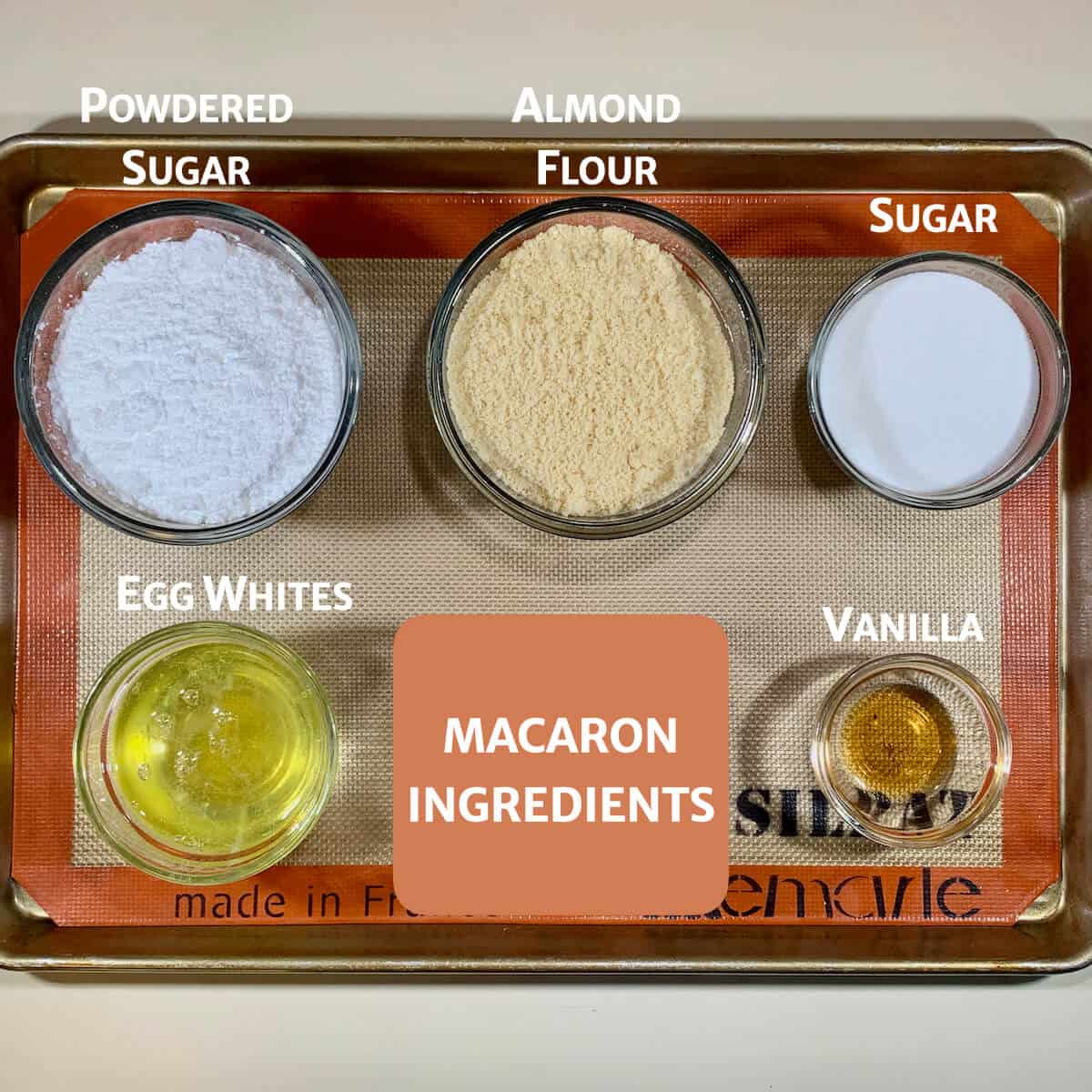
Ingredient Notes
Egg whites: For a successful meringue, the egg whites need to be absolutely free of fat to whip. To make sure there is no yolk, I suggest you separate the eggs over a bowl and dump the whites into another bowl (an egg separator can help). Also, wiping the mixing bowl with white vinegar or lemon juice prior to adding the whites helps to ensure there is no fat in the bowl that can inhibit the meringue formation. This step is optional but highly recommended.
Room-temperature egg whites whip up better than cold egg whites. For room temperature eggs, leave them out on the counter for 1 hour or submerge them in warm water for 5 minutes.
Almond Flour: There are two types of almond flour available, blanched and unblanched, the difference being whether or not the almonds are ground up with their skins. If the color of the macaron is going to be light, use the lighter-shaded blanched almond flour. Note, almond flour is not almond meal. You want the finer grind of the flour for this recipe. You can even make your own homemade almond flour.
Cream of tartar (not pictured): An acidic dry powder that's a byproduct of winemaking. It's used to stabilize the egg whites as they're being whipped, so you get a fluffier finished meringue. It's optional, but recommended.
Flavorings: You can flavor your French macarons with extracts other than vanilla. Use ¼ teaspoon for stronger flavors like almond, mint, or Fiori di Sicilia (an orange vanilla extract). Dried powdered fruits are an option, like in this pink peppercorn macaron. Or, try using cocoa powder in the batter. The possibilities are endless!
Coloring: If you want to color your buttercream, gel food coloring works best because it won't thin the product. The color does fade as it bakes, so do a shade or two darker than you want them to be.
Fillings: You have many options for filling the macarons. See below for some ideas.
See the recipe card for a full list of ingredients and measurements.
Macaron fillings are up to you
You’ll notice I didn’t include a filling recipe because there you can get creative. Here are some ideas to get you started:
- Buttercream: Make a classic buttercream frosting or an Italian meringue frosting in a complementary flavor and color
- Chocolate: A whipped chocolate ganache makes an intense filling flavor
- Caramel: Likewise, a thick caramel sauce can be spread on warm, then cool to set
- Cookies & cream: Place Oreo cookies with their filling in a food processor until smooth and creamy
- S'mores: Use crushed graham crackers, melted marshmallow, and chocolate ganache
- Other ideas: fruit curds, homemade jam, peanut butter...the list goes on.
The macarons pictured below are filled with purple buttercream frosting and lemon curd thickened with powdered sugar. For a more intense purple filling, try using this ube butter.
How to make macarons
The steps to making a French macaron recipe from scratch are, in and of themselves, simple. Make a French meringue, stir in sweetened almond flour, then bake.
Ok, there's a little more to it than that.
Step 1: Sift the almond flour and powdered sugar
Sift finely ground almond meal and powdered sugar together, preferably passing them both through a fine-mesh strainer or using a sifter (photo 1).

Step 2: Make the meringue
Wet a paper towel with white vinegar or lemon juice and wipe the bowl of a stand mixer. Any bit of residual fat in the bowl can keep the meringue from forming. The acid ensures that the bowl is absolutely free of fat.
Beat egg whites until foamy, then add the granulated sugar, cream of tartar, and salt (photo 2). Whip until the meringue can form a peak that stands upright (a stiff peak), about 8 to 10 minutes.

Now is the time to add any food coloring if you'd like (photo 3). Gel food coloring works best. The color does fade as it bakes, so do a shade or two darker than you want them to be.
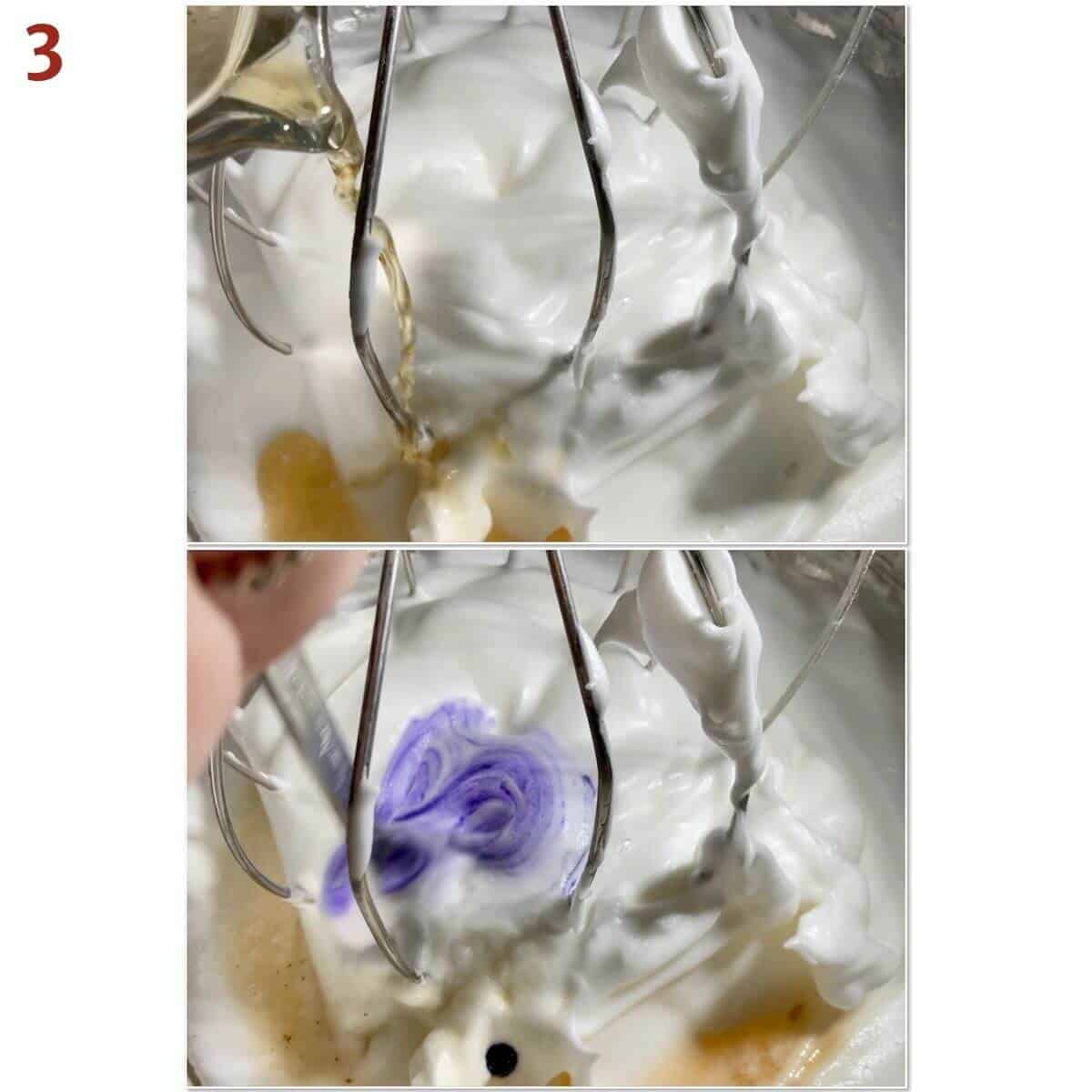
Double check that the meringue is whipped to stiff peaks (photo 4).

Step 3: Fold in the almond flour mixture
Folding in the almond flour mixture into the meringue is the trickiest part to making macarons (photo 5). About 65 to 75 turns of your spatula is the magic number.
Under-mix, and your macarons will be lumpy and cracked when they bake and won't have feet. Over-mix and your macarons will be flat and still won't have feet.
More on that later.

Line a half sheet baking pan lined with a Silpat silicone mat or parchment paper.
Transfer the macaron batter to a piping bag fitted with a ½-inch round pastry tip. If you're using parchment paper, place a little of the macaron batter on the underside of each corner to hold it flat to the baking pan.
Pipe out 1½-inch rounds onto the baking pan, spacing them about 1-inch apart (photo 6). Use a wet finger to gently flatten the points from the batter.
Tap the pan hard at least 2 to 3 times to release the air bubbles. This will prevent the tops of the macarons from cracking.
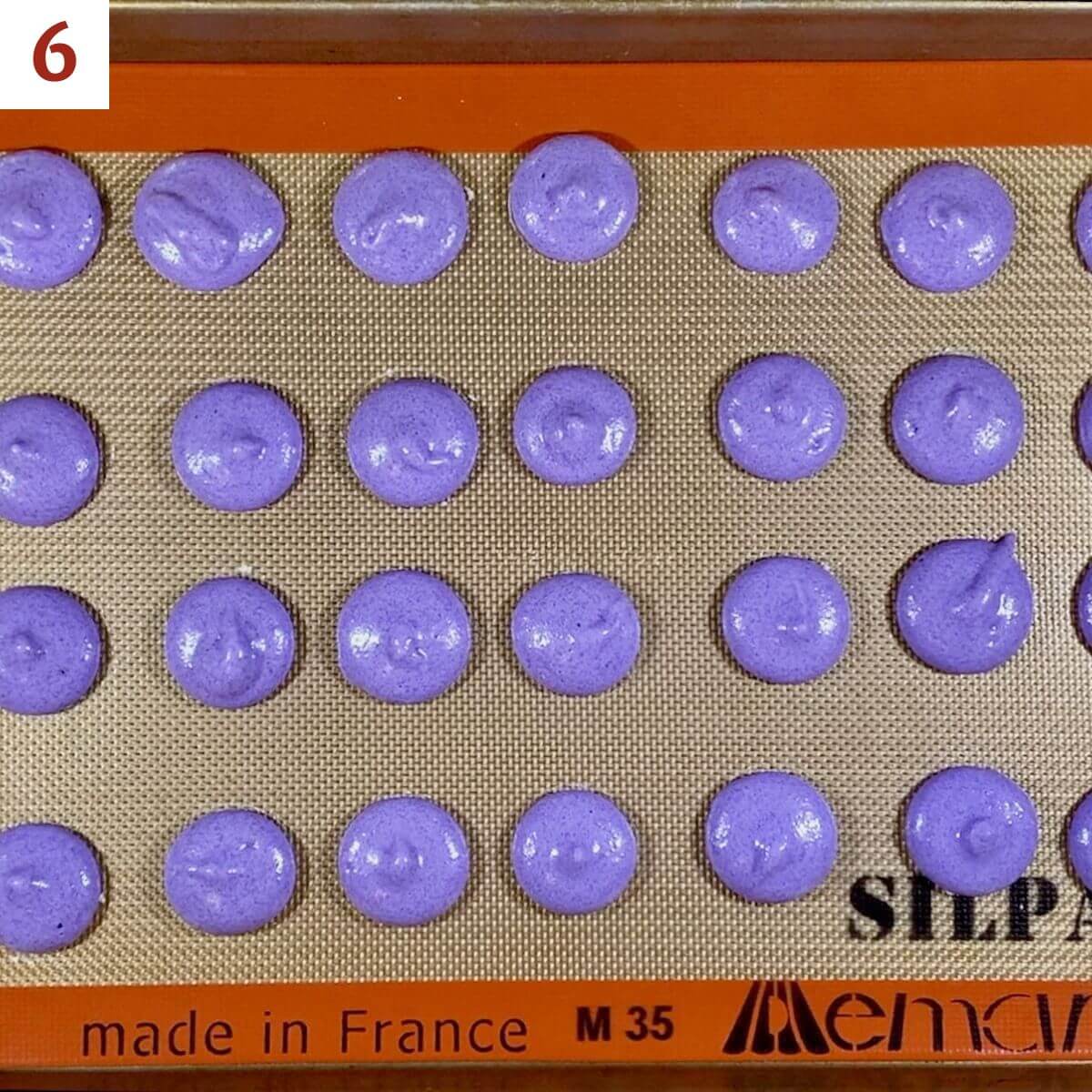
Step 4: Dry the macarons before baking
Allowing the macaron batter to dry before going into the oven is a very important step. When they dry out they can't spread out in the oven, and are forced to rise up. That's what creates the distinctive feet you want!
Let the macarons sit out for 30 to 60 minutes, allowing them time to dry out a bit before hitting the hot oven. The batter should be tacky, but not stick to your fingertips.
How to avoid macarons with no feet
The first time my daughter and I made a macaron recipe, we felt like we knew what to do and dived right in…and failed. These were macarons with no feet and no height, and not what we were going for.
[insert tires screeching sound here]
The solution to flat, footless macarons is to allow the time to dry the meringue shells before baking. I can't emphasize that enough - don't skip this step!

Step 5: Bake the macarons
Bake the macarons at 300°F for 20 minutes (photo 7). Warning: do not underbake, even if they look done. Otherwise they will stick to your tray. Just bake for the prescribed time and have faith.
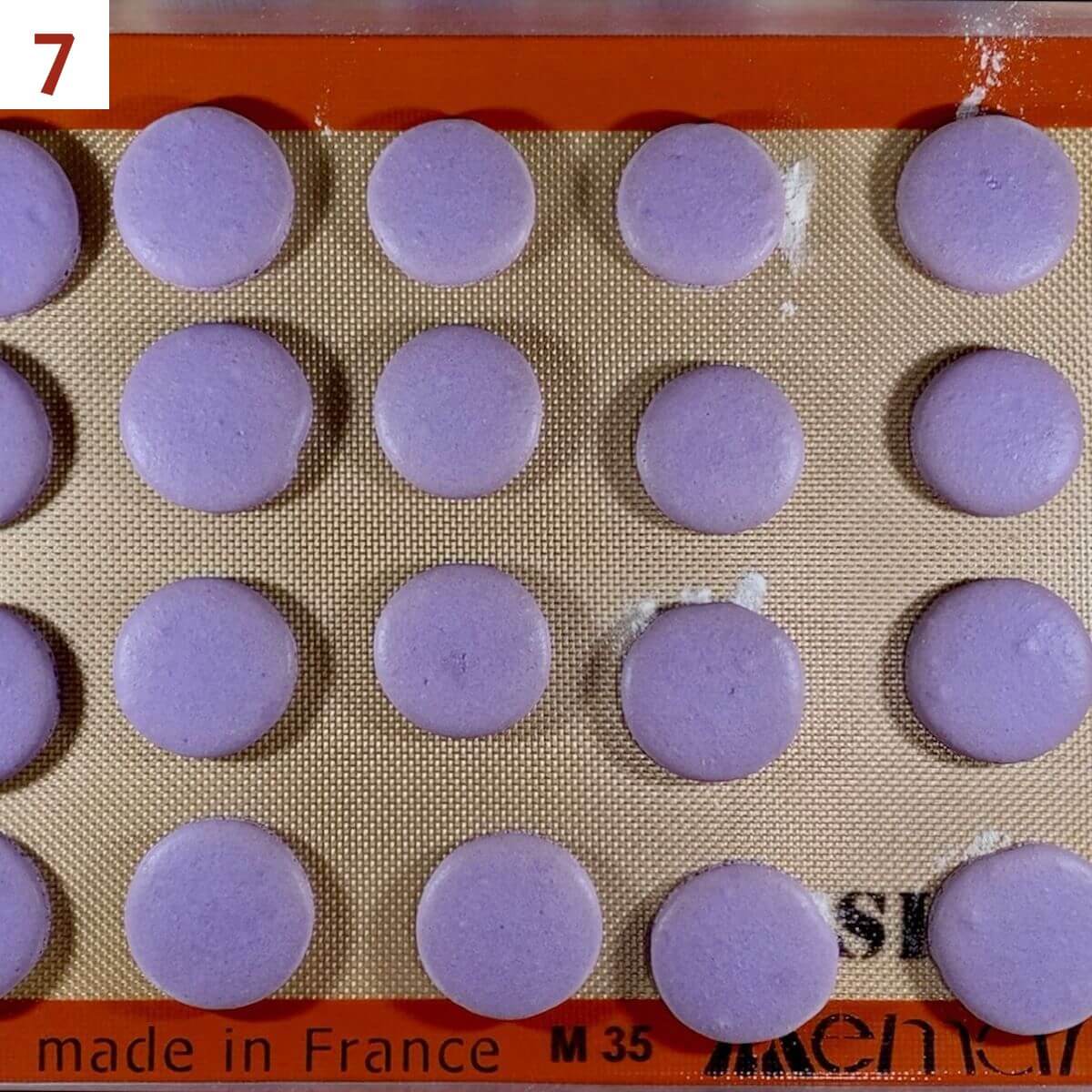
Turn off the oven once the macarons are done without opening the oven door to let them cool completely in the oven (about 1 to 2 hours) before removing the pan. This will keep them from cracking due to thermal shock.
Voilà, perfectly puffed macarons with their distinctive feet!

Storage and make-ahead instructions
Macarons are best enjoyed the next day as the meringue shells have a chance to soften to a crispy chewiness.
Storage instructions: Macarons can be stored in an air-tight container at room temperature for up to a week, unless you have a filling that must be refrigerated.
Make ahead instructions: Macaron shells can be frozen in an airtight container for up to two months. There's no need to thaw them first before filling.
Tips for French macaron success
Here are some more expert tips for making French macarons:
- Be patient when you sift the powdered sugar and almond flour together. This step can be tedious (especially if you don't have a sifter), but it's important to make the powder as smooth as possible and remove any larger almond pieces that would make the shells look less than ideal.
- Allow the meringue shells to dry before going into the oven. When they dry out, the shells can't spread out in the oven, and are forced to rise up (that's what creates the feet).
- For a more stable meringue, think about making Italian meringue macarons instead. The cooked Italian meringue is more forgiving when folding in the almond flour mixture, thus giving better results.

Questions asked and answered
Here are some questions that you might have...
Fresh out of the oven, macaron shells will be quite crisp and delicate. If you fill them and eat them immediately, the shells will still have that extra-crisp texture. However, macarons are best enjoyed the next day as the meringue shells have a chance to soften to a crispy chewiness. Yummm...
There can be a number of reasons for hollow macaron shells: (1) The eggs were too fresh - relaxing the egg protein by letting the egg whites rest in the refrigerator for a day or two will help; (2) There could have been air trapped in the batter - that's why we tap the pan before baking; (3) The oven might be too hot - reduce the temperature 25˚F next time.
The difference is in how the meringue is made. French meringue is just egg whites beaten until fluffy and sweetened with sugar. In Italian meringue macarons, the sugar is boiled into a syrup before adding it to the whipped egg whites. As it's slowly added to the bowl, the egg whites cook, giving the resulting meringue a sturdier structure that's less brittle than French meringue.


Recipes using egg yolks to try
Recipe

Perfect French Macarons
Equipment
Ingredients
- 1 cup powdered sugar
- ¾ cup almond flour, see Recipe Notes
- 1 teaspoon white vinegar, or lemon juice, optional, see Recipe Notes
- 2 large egg whites, at room temperature
- ¼ cup granulated sugar
- ¼ teaspoon cream of tartar
- pinch kosher salt
- ½ teaspoon pure vanilla extract, see Recipe Notes
- food coloring, optional, see Recipe Notes
- fillings, see Recipe Notes
Instructions
- Line a half sheet baking pan with a Silpat silicone mat or parchment paper. Set aside.
- Sift together the powdered sugar and the almond flour. Discard the larger lumps of almond pieces left behind.
- Wet a paper towel with white vinegar or lemon juice and wipe the bowl of a stand mixer. Place the egg whites in the bowl and fit the mixer with the whisk attachment.
- Beat egg whites until foamy, then add the granulated sugar, cream of tartar, and salt. Whip until the meringue can form a peak that stands upright, about 6 to 8 minutes. Add the vanilla and the food coloring (if using).
- Gently fold the almond flour mixture into the meringue, counting about 65 to 75 turns of your spatula. Folding in the almond flour mixture into the meringue is the trickiest part. Under-mix, and your macarons will be lumpy and cracked when they bake and won't have feet. Over-mix and your macarons will be flat and still won't have feet.
- Transfer the batter to a pastry bag. If you’re using parchment paper, place a little of the batter on the underside of each corner to hold it flat to the baking pan. Pipe out 1½-inch rounds onto the baking pan. Use a wet finger to gently flatten the points from the batter.
- Tap the pan hard on the counter at least 2 to 3 times to release the air bubbles. This will prevent the tops of the meringue shells from cracking.
- Let the meringue shells sit out for 30 to 60 minutes, allowing them time to dry out a bit before hitting the hot oven. They should be tacky, but not stick to your fingertips. Allowing the macaron batter to dry before going into the oven is a very important step. When they dry out they can't spread out in the oven, and are forced to rise up (that's what creates the feet).
- While the macarons are drying, preheat the oven to 300 °F.
- Bake the meringue shells for 20 minutes. Do not underbake, even if they look done (otherwise they will stick to your tray).
- Turn off the oven once the shells are done without opening the oven door to let them cool completely in the oven (about 1 to 2 hours) before removing the pan. This will keep them from cracking due to thermal shock.
- Macarons are best enjoyed the next day as the meringue shells have a chance to soften to a crispy chewiness.
- Storage instructions: Macarons can be stored in an air-tight container at room temperature for up to a week, unless you have a filling that must be refrigerated.
- Make ahead instructions: Macaron shells can be frozen in an airtight container for up to two months. There's no need to thaw them first before filling.





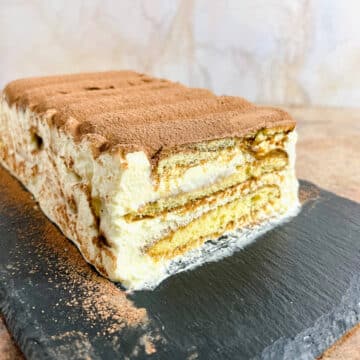


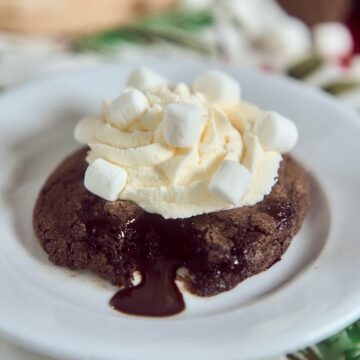
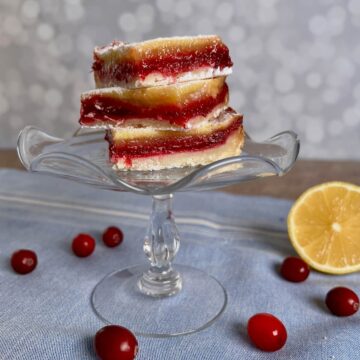
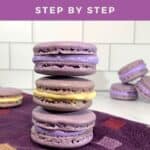

Catherine says
I’ve been discouraged every time I try to make macarons as they never seem to work but I actually got a batch to work with these tips. You’re right, seeing the feet is a fantastic feeling!